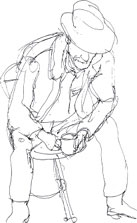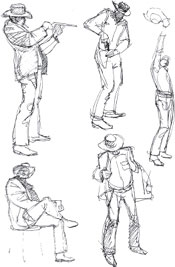134 Relationship of Character to Prop
Too bad we can’t have two models to work with in the evening class. It would give an opportunity to study relationships, which is something we have to deal with in animation. However, the next best thing is props and I try to incorporate them as much as possible. I am constantly imploring the students to build their gesture drawings around them because they tell what the pose is all about — what I call the “story” of the drawing. In animation you are dealing with the same thing. The only difference is the story has continuity to it. But the relationship between characters and props is exactly the same.
The prop could be an umbrella, which might suggest rain, or a parasol that might suggest an oppressive sun. A model using a telephone should spark some kind of a response in you; perhaps it’s a call for help, or a social call, or an unwanted call from a former spouse, or a salesperson. Your mind should be free from the nitty-gritty of anatomy and other non-pertinent details to allow you to fabricate an imaginative story behind the pose. A simple prop like a hat can be used to shade the sun, hide a bald spot, or just spark up an outfit. Whatever the prop it ought to be considered in its relationship to the character that is using it. Disregard the proper use of a prop and you create a situation that can be disconcerting to your audience. Props have meaning and they deserve to be dealt with in a meaningful way.
Prop in theater jargon, is short for property. That means anything to do with the story, the action, or the role of the actor. It is even used attributively; meaning some part of a character’s character. A stutter or some mannerism can be thought of as a prop. All characters have personalities that are identified by certain attributes. These have to be kept straight or the character becomes diluted or weakened. External props such as umbrellas or guns, etc., are no less important to a character. How she handles the prop reveals her character as applied to the plot or story.
Last week I modeled for the class, using an abundance of props to challenge everyone to make maximum use of them. The response was very gratifying. I confiscated some of the drawings for you to study in light of the magnificent way in which the props and the gestures were utilized. Here are some of Bill Berg’s. He comes into the class with an air of confidence and eager anticipation that shows in his drawings. I’ve never timed these poses, but they’re in the neighborhood of 8 to 10 minutes. Bill captures a lot in those 10 minutes.

James Fujii, a “regular” at the Tuesday and Wednesday classes, has become quite proficient at going for the guts of the gesture. His drawings below are not photographic copies but are truly lifelike gesture drawings any animator would be proud of, had he made them.

A while back I told you about Wendy Werner, who was new to drawing. She is still trying and succeeding. These drawings on the next page suggest that she is looking and seeing third dimensionally. The gestures are very clear.

Dylan Kohler, another newcomer to drawing, demonstrates how one, without any formal training in anatomy or drawing, can, in spite of the seeming disadvantage, directs his attention to the important elements of a gesture drawing and come up with a convincing “story” drawing (just as in good English you should never construct that long a sentence — but my excuse is, it says what it has to say….).


Dan Boulos is an energetic sketcher. He draws with great impetus, seemingly impatient to get to the gesture without all the humdrum of detail. But even without the fine-tuning of the details there is no doubt about what the props are and how they fit into the “story.”


